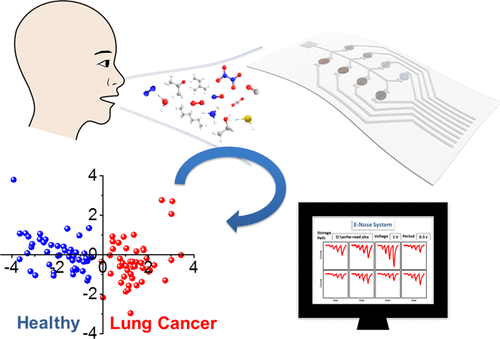当前位置:
X-MOL 学术
›
ACS Appl. Mater. Interfaces
›
论文详情
Our official English website, www.x-mol.net, welcomes your
feedback! (Note: you will need to create a separate account there.)
Constructing an E-Nose Using Metal-Ion-Induced Assembly of Graphene Oxide for Diagnosis of Lung Cancer via Exhaled Breath
ACS Applied Materials & Interfaces ( IF 8.3 ) Pub Date : 2020-04-01 , DOI: 10.1021/acsami.0c00720 Qiaofen Chen 1 , Zhao Chen 2 , Dong Liu 1 , Zhengfu He 2 , Jianmin Wu 1
ACS Applied Materials & Interfaces ( IF 8.3 ) Pub Date : 2020-04-01 , DOI: 10.1021/acsami.0c00720 Qiaofen Chen 1 , Zhao Chen 2 , Dong Liu 1 , Zhengfu He 2 , Jianmin Wu 1
Affiliation

|
A flexible electronic-nose (E-nose) was constructed by assembling graphene oxide (GO) using different types of metal ions (Mx+) with different ratio of GO to Mx+. Owing to the cross-linked networks, the Mx+-induced assembly of graphene films resulted in different porous structures. A chemi-resistive sensor array was constructed by coating the GO–M hybrid films on PET substrate patterned with 8 interdigited electrodes, followed by in situ reduction of GO to rGO with hydrazine vapor. Each of the sensing elements on the sensor array showed a cross-reactive response toward different types of gases at room temperature. Compared to bare rGO, incorporation of metal species into rGO significantly improved sensitivity owing to the additional interaction between metal species and gas analyte. Principle component analysis (PCA) showed that four types of exhaled breath (EB) biomarkers including acetone, isoprene, ammonia, and hydrothion in sub-ppm concentrations can be discriminated well. To overcome the interference from humidity in EB, a protocol to collect and analyze EB gases was established and further validated by simulated EB samples. Finally, clinical EB samples collected from patients with lung cancer and healthy controls were analyzed. In a 106 case study, the healthy group can be accurately distinguished from lung cancer patients by linear discrimination analysis. With the assistance of an artificial neural network, a sensitivity of 95.8% and specificity of 96.0% can be achieved in the diagnosis of lung cancer based on the E-nose. We also find that patients with renal failure can be distinguished through comparison of dynamic response curves between patient and healthy samples on some specific sensing elements. These results demonstrate the proposed E-nose will have great potential in noninvasive disease screening and personalized healthcare management.
中文翻译:

使用金属离子诱导的氧化石墨烯组装体构建电子鼻,以通过呼气诊断肺癌
通过使用具有不同GO与M x +比例的不同类型的金属离子(M x +)组装氧化石墨烯(GO)来构建柔性电子鼻(E-nose)。由于具有交叉链接网络,因此M x +诱导的石墨烯膜组装导致不同的多孔结构。通过在具有8个叉指电极图案的PET基板上涂覆GO-M杂化膜,然后用肼蒸气将GO原位还原为rGO,来构建化学电阻传感器阵列。传感器阵列上的每个传感元件在室温下均表现出对不同类型气体的交叉反应响应。与裸rGO相比,由于金属种类与气体分析物之间存在额外的相互作用,因此将金属种类并入rGO可以显着提高灵敏度。主成分分析(PCA)表明,可以很好地区分四种类型的呼气(EB)生物标志物,包括丙酮,异戊二烯,氨水和亚ppm级浓度的氢硫磷。为了克服EB中的湿度干扰,建立了收集和分析EB气体的协议,并通过模拟EB样品进行了进一步验证。最后,分析了从肺癌患者和健康对照中收集的临床EB样品。在106个案例研究中,可以通过线性判别分析将健康组与肺癌患者区分开。借助人工神经网络,在基于E型鼻的肺癌诊断中可以达到95.8%的敏感性和96.0%的特异性。我们还发现,可以通过比较患者和健康样品在某些特定传感元件上的动态响应曲线来区分肾衰竭患者。这些结果表明,提出的电子鼻在非侵入性疾病筛查和个性化医疗保健管理中将具有巨大潜力。
更新日期:2020-04-01
中文翻译:

使用金属离子诱导的氧化石墨烯组装体构建电子鼻,以通过呼气诊断肺癌
通过使用具有不同GO与M x +比例的不同类型的金属离子(M x +)组装氧化石墨烯(GO)来构建柔性电子鼻(E-nose)。由于具有交叉链接网络,因此M x +诱导的石墨烯膜组装导致不同的多孔结构。通过在具有8个叉指电极图案的PET基板上涂覆GO-M杂化膜,然后用肼蒸气将GO原位还原为rGO,来构建化学电阻传感器阵列。传感器阵列上的每个传感元件在室温下均表现出对不同类型气体的交叉反应响应。与裸rGO相比,由于金属种类与气体分析物之间存在额外的相互作用,因此将金属种类并入rGO可以显着提高灵敏度。主成分分析(PCA)表明,可以很好地区分四种类型的呼气(EB)生物标志物,包括丙酮,异戊二烯,氨水和亚ppm级浓度的氢硫磷。为了克服EB中的湿度干扰,建立了收集和分析EB气体的协议,并通过模拟EB样品进行了进一步验证。最后,分析了从肺癌患者和健康对照中收集的临床EB样品。在106个案例研究中,可以通过线性判别分析将健康组与肺癌患者区分开。借助人工神经网络,在基于E型鼻的肺癌诊断中可以达到95.8%的敏感性和96.0%的特异性。我们还发现,可以通过比较患者和健康样品在某些特定传感元件上的动态响应曲线来区分肾衰竭患者。这些结果表明,提出的电子鼻在非侵入性疾病筛查和个性化医疗保健管理中将具有巨大潜力。











































 京公网安备 11010802027423号
京公网安备 11010802027423号